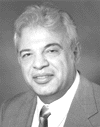
2000 TMS Annual Meeting: Hume-Rothery Award Symposium and Award Presentation
March 12—16 · 2000 TMS ANNUAL
MEETING · Nashville, Tennessee
During the week of March 12-16, 2000, the 129th Annual
Meeting & Exhibition of The Minerals, Metals &
Materials Society (TMS), will be held in Nashville, Tennessee, at the Opryland Hotel and Convention Center.
The Hume-Rothery Award was established
in 1972 by the Institute of Metals Division of TMS and
recognizes outstanding scholarly contributions to the science of alloys. The award
includes an invitation to the recipient to be the honored lecturer at the William
Hume-Rothery Memorial Symposium during the TMS Annual Meeting.
"Theoretical Characterization of Alloy Structures at Microscopic and Mesoscopic
Scales"
Sponsored by: Jt. EMPMD/SMD Alloy Phases Committee
Presented by: Prof. Armen G. Khachaturyan, Rutgers University
When: Monday, March 13, 2000
Time: 2:00 p.m.
Room: Johnson A/B
About the topic: Development of the theory of alloy structure from atomic
to nanoscale level is discussed. It is shown that the structure on the atomic scale
is described by the occupation probability function, which can be formulated in terms
of Static Concentration Waves. Amplitudes of the waves are the long-range order parameters,
the wave vectors are the superlattice reciprocal lattice vectors. This approach is
especially effective in the mean-field approximation. However, it was also successfully
used if the correlation effects are taken into account. The Concentration Wave method
describes both the atomic scale and the nanoscale (if the variation of lro parameters
becomes considerable). With this feature, this method provides a bridge between the
scales. It is shown how this method can be used to make an accurate transition to
the Phase Field theory of evolution of the microstructure on the mesoscopic scale.
The Phase Field theory of the mesoscopic microstructure evolution in coherent structurally
inhomogeneous alloys with multivariant domains of ordered intermetallics is discussed.
The evolution is driven by the minimization of transformation strain. This theory
is based on the Phase Field micromechanics incorporated in the alloy thermodynamics.
This approach allows one to realistically simulate the mesoscopic microstructure
evolution for a wide spectrum of materials (metal and ceramics) with different types
of transformations (diffusional and displacive). Input data required to carry out
the computer simulation are the crystal lattice parameters, compositions and elastic
moduli of phases, and the interfacial energy.
About Prof. Khachaturyan: Prof. Khachaturyan studied at Steklov Institute
of Mathematics of the Soviet Academy of Sciences, Moscow, USSR (Ph.D. 1963), and
Metal Physics Institute of Ukrainian Academy of Sciences, Kiev, USSR (Doctor of Science
1971)
Experience: 1962-1973 Senior Research Scientist of the Theoretical Physics
Lab of the Metal Physics Institute of the Central Research Institute for Ferrous
Metallurgy, Moscow; 1973-1986 - Senior Research Scientist in the Institute of Crystallography
of the Academy of Science of the USSR; 1986-1988 - Senior Scientist at the Lawrence
Berkeley Lab, Berkeley, CA; 1988-Present - State of New Jersey Chair Professor at
Rutgers, The State University, New Brunswick, NJ.
Awards: Prof. Khachaturyan has received the following honors and awards:
B. T. Mathias Scholar Award, Los Alamos National Laboratory; "The Theory of
Structural Transformation in Solids" was named the Most Outstanding Book in
Engineering in the 8th Annual Professional and Scholarly Book Awards, The American
Association of Publishers; two papers recognized as Best Soviet Paper of the Year
(1969 and 1975) in Solid State Theory, Soviet Academy of Science; two awards of the
Institute of Crystallography of the Academy of Science; and Visiting Professor, Department
of Materials Science and Engineering, Berkeley, CA.
The information on this page is maintained by the TMS Meetings
Department (mtgserv@tms.org).

